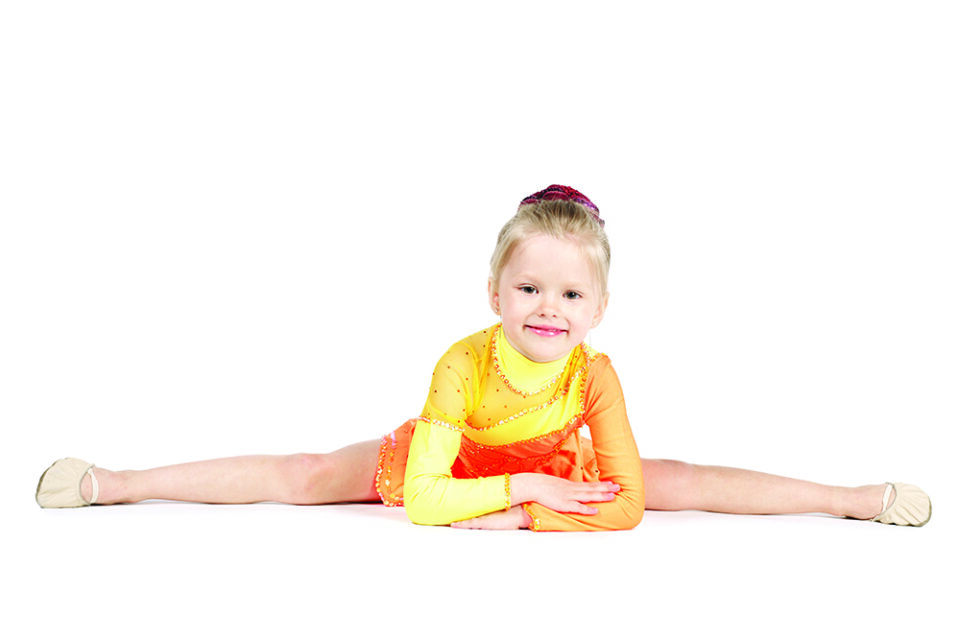Olympian McKayla Maroney’s “not impressed” meme aside, gymnastics calls to mind visions of poise, grace and strength — qualities your tumbling tot likely hasn’t mastered yet. But hey, everyone has to start somewhere, and gymnastics is a great way to take advantage of children’s natural curiosity, as well as help them develop strong bodies, minds, and confidence.
Ready, Set, Grow!
“Gymnastics is an ideal sport for preschoolers as it builds on their natural curiosity of how their bodies work, and their curiosity of the world around them,” says Rebecca Bruggeman, owner and operator of Go 2 Grow Gymnastics. Young brains absorb and learn quickly, making the preschool years an ideal time to introduce children to new skills. Plus, with Mom or Dad nearby, your child can feel safe and may be more willing to try new things. Says Page Helmick, owner of The Little Gym in Mason, “Gymnastics is a sport that embraces the preschooler’s desire to run, jump and fly while capitalizing on their willingness to be adventurous and take some risks.”
The good thing about beginning gymnastics at a young age is that your child doesn’t have to meet a lot of requirements before hitting the mats. Says Katie Meinerding, preschool director at Cincinnati Gymnastics, “Kids should be walking before starting a class either with their mom or independently.”
“It is more important that each child be socially/emotionally ready versus having any specific skill,” says Bruggeman. She adds that children under 3 should participate with a parent as they are not necessarily ready to separate from “guided help.” Children who are potty trained show a degree of body control and awareness, she says, and that is often a sign that they are ready to participate in class independent of their parents.
What to Expect When Getting Started
At The Little Gym, kids participate in dance, karate and other sports, along with gymnastics. “Each of our classes are centered around a similar structure (warm up, group activity, stations and games),” says Helmick, adding that the elements vary each week. The program includes fun themes like Fantasy Castle and Wild West to keep kids interested. Dance classes include gymnastics, and the karate classes focus on the basics rather than following a belt system. “Our sports classes introduce a new sport every three or four weeks,” says Helmick, “breaking down each one into the fundamental principles, just to get the kids familiar with the various strategies and appropriate equipment for that particular sport.” The sports classes also include a gymnastics element.
Children can begin at The Little Gym as young as 4 months of age in a parent/child classes. “We use the parents to assist and get children comfortable taking instruction from the teachers and learning how to create relationships with other children their age,” says Helmick.
Because gymnastics involves a lot of repetition and preschoolers aren’t necessarily ready for that, Go 2 Grow focuses on a variety of skills and equipment in a creative way — for example, children will experience a pirate adventure one day, and pretend to be zoo animals the next. “The key in this process is to get all our children’s body parts to be able to talk to one another as they are moving,” says Bruggeman, adding that this also prepares children to enjoy trying new things, along with learning about concepts like taking turns, sharing, and listening. Most classes average 45 minutes to an hour, with sessions lasting from 12 – 18 weeks.
Cincinnati Gymnastics moves children through a progression of skills — in the Mommy and Me class, tots will hang, hold, walk, roll and jump while building comfort and confidence with the gym. Two-year-olds focus on learning to follow directions, trusting their teachers and getting along with others, while 3-year-olds learn more about body control while focusing taking turns. As kids get older, class gets a little longer — 60 minutes for ages 4 and 5, and 75 to 90 minutes for “Superoos,” a class designed for 4- and 5-year-olds who have mastered core skills.
Your Role
The amount of time you put into your child’s gymnastics is really up to you at this young age. Helmick recommends parents begin slowly, with maybe devoting only an hour a week, then progressing from three to four days a week.
“Children have only limited time to be children,” she says. “We must remember this when we have the urge to have them compete in the primary grades.”
A parent’s role during classes is to provide support, encouragement, and role modeling, according to Bruggeman. Meinerding recommends parents involve themselves with moderation. “Parent should be loving and encouraging,” she says, “but allow the teacher and the student to form their own relationship inside the gym.”
Says Helmick, “As parents, it is critically important to let our children know that we will be their champion and we will respect them, while also communicating that we expect them to follow through on commitments and be kind to their friends. We must recognize their accomplishments, as each victory is a stepping stone to the next, and also challenge them to reach the next step.” Whether you’re actually on the floor and joining your child for activities, or being a cheerleader from the sidelines, it’s up to you to bring a positive attitude to the class and make it fun for everyone!





